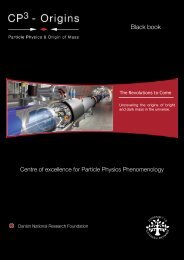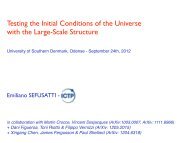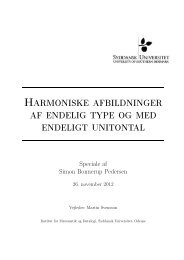2nd Black Book - CP3-Origins
2nd Black Book - CP3-Origins
2nd Black Book - CP3-Origins
Create successful ePaper yourself
Turn your PDF publications into a flip-book with our unique Google optimized e-Paper software.
Composite Higgs to two Photons and Gluons<br />
We introduced a simple framework to estimate the composite Higgs boson coupling to twophoton<br />
in Technicolor extensions of the standard model. The same framework allows us to predict<br />
the composite Higgs to two-gluon process. We compare the decay rates with the standard<br />
model ones and show that the corrections are typically of order one. We suggest, therefore, that<br />
the two-photon decay process can be efficiently used to disentangle a light composite Higgs<br />
from the standard model one. We also show that the Tevatron results for the gluon-gluon fusion<br />
production of the Higgs either exclude the techniquarks to carry color charges to the 95% confidence<br />
level, if the composite Higgs is light, or that the latter must be heavier than around 200<br />
GeV.<br />
Mass Deformed Exact S-parameter in Conformal Theories.<br />
Francesco Sannino (Southern Denmark U., <strong>CP3</strong>-<strong>Origins</strong>). <strong>CP3</strong>-ORIGINS-2010-21. Jun 2010. 4 pp.<br />
Published in Phys.Rev. D82 (2010) 081701<br />
e-Print: arXiv:1006.0207 [hep-lat]<br />
Exact Flavor Dependence of the S-parameter.<br />
Stefano Di Chiara, Claudio Pica, Francesco Sannino, (Southern Denmark U., <strong>CP3</strong>-<strong>Origins</strong>) . <strong>CP3</strong>-ORIGINS-<br />
2010-32, Aug 2010. 8pp.<br />
e-Print: arXiv:1008.1267 [hep-ph]<br />
Dark Matter and Composite Inflation<br />
Mixed dark matter from technicolor<br />
We studied natural composite cold dark<br />
matter candidates which are pseudo<br />
Nambu-Goldstone bosons (pNGB) in<br />
models of dynamical electroweak symmetry<br />
breaking. Some of these can have<br />
a significant thermal relic abundance,<br />
while others must be mainly asymmetric<br />
dark matter. By considering the thermal<br />
abundance alone we find a lower bound<br />
of MW on the pNGB mass when the<br />
(composite) Higgs is heavier than 115<br />
GeV. Being pNGBs, the dark matter candidates<br />
are in general light enough to be<br />
produced at the LHC.<br />
Mixed dark matter from technicolor.<br />
Alexander Belyaev, (Southampton U. & Rutherford) , Mads T. Frandsen,, Francesco Sannino, (Southern<br />
Denmark U., <strong>CP3</strong>-<strong>Origins</strong>), Subir Sarkar, (Oxford U., Theor. Phys.). Jul 2010. (Published Jan 1, 2011). 9pp.<br />
Published in Phys.Rev.D83:015007,2011.<br />
e-Print: arXiv:1007.4839 [hep-ph]<br />
Constraining Asymmetric Dark Matter through observations of compact stars<br />
We put constraints on asymmetric dark matter candidates with spin-dependent interactions<br />
based on the simple existence of white dwarfs and neutron stars in globular clusters. For a wide<br />
range of the parameters (WIMP mass and WIMP-nucleon cross section), WIMPs can be trapped<br />
in progenitors in large numbers and once the original star collapses to a white dwarf or a neu-<br />
20 CP³-<strong>Black</strong> book








